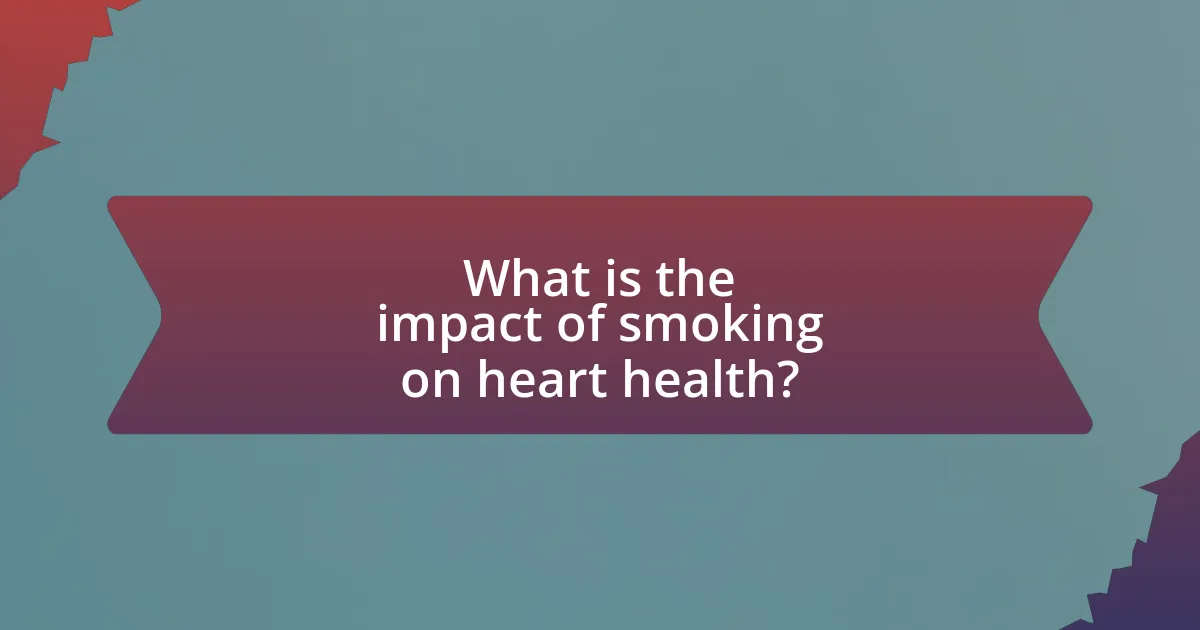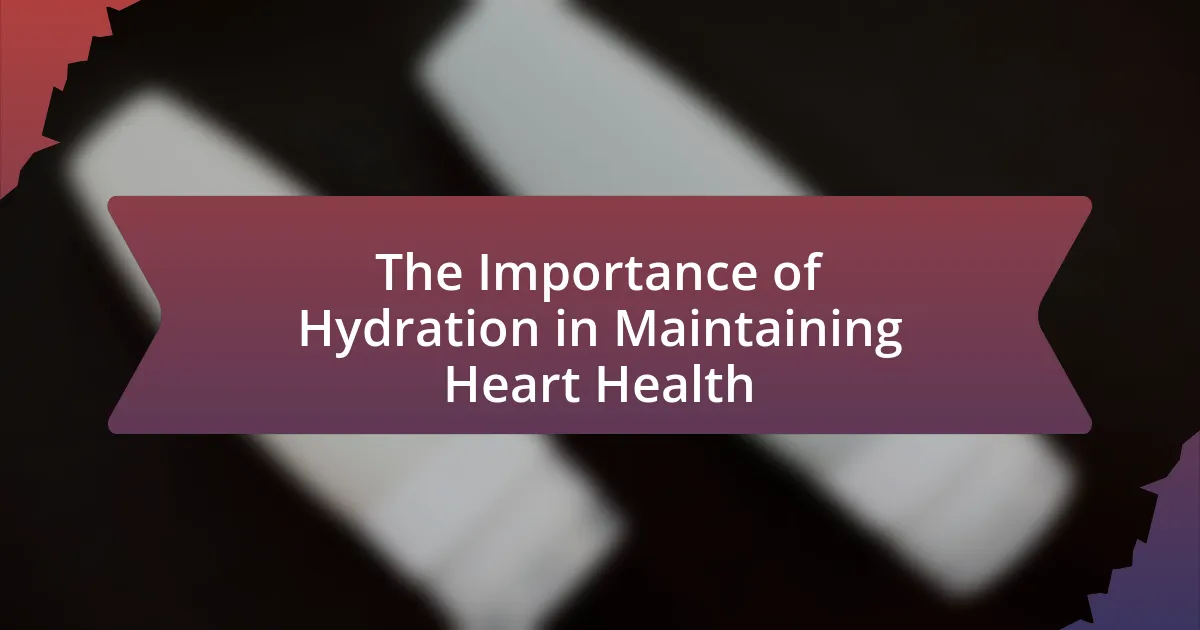The article focuses on the significant impact of smoking on heart health, highlighting how smoking increases the risk of heart disease through mechanisms such as atherosclerosis, elevated blood pressure, and heart rate. It details the specific cardiovascular diseases linked to smoking, including coronary artery disease and stroke, and emphasizes the physiological effects of nicotine and other harmful chemicals in tobacco. The article also discusses the benefits of quitting smoking, including rapid improvements in heart health and long-term risk reduction, while addressing the challenges individuals face during cessation and effective strategies to support quitting. Additionally, it outlines lifestyle changes that can further enhance heart health post-smoking, such as diet and exercise, and the importance of support systems in maintaining a smoke-free life.

What is the impact of smoking on heart health?
Smoking significantly increases the risk of heart disease. It contributes to the development of atherosclerosis, where plaque builds up in the arteries, leading to reduced blood flow and increased chances of heart attacks. According to the American Heart Association, smokers are two to four times more likely to develop coronary heart disease compared to non-smokers. Additionally, smoking raises blood pressure and heart rate, further straining the cardiovascular system. The harmful chemicals in tobacco smoke damage blood vessels and promote clot formation, which can result in serious cardiovascular events.
How does smoking affect cardiovascular function?
Smoking negatively impacts cardiovascular function by causing damage to blood vessels and increasing the risk of heart disease. The chemicals in tobacco smoke lead to inflammation and oxidative stress, which contribute to the development of atherosclerosis, a condition characterized by the buildup of plaque in arteries. According to the American Heart Association, smokers are two to four times more likely to develop coronary heart disease compared to non-smokers. Additionally, smoking raises blood pressure and heart rate, further straining the cardiovascular system. These effects collectively increase the likelihood of heart attacks and strokes, underscoring the critical need for smoking cessation to improve heart health.
What are the specific cardiovascular diseases linked to smoking?
Smoking is linked to several specific cardiovascular diseases, including coronary artery disease, stroke, and peripheral artery disease. These conditions arise due to the harmful effects of tobacco smoke, which contributes to the buildup of plaque in arteries, increases blood pressure, and promotes blood clot formation. According to the American Heart Association, smokers are twice as likely to suffer from heart disease compared to non-smokers, highlighting the significant impact of smoking on cardiovascular health.
How does smoking influence blood pressure and heart rate?
Smoking increases blood pressure and heart rate due to the stimulatory effects of nicotine and other chemicals in tobacco. Nicotine causes the release of adrenaline, which leads to an increase in heart rate and constriction of blood vessels, resulting in elevated blood pressure. Studies indicate that smokers have a higher resting heart rate compared to non-smokers, with an average increase of 10 to 20 beats per minute. Additionally, chronic smoking can lead to long-term hypertension, contributing to cardiovascular diseases.
Why is smoking considered a major risk factor for heart disease?
Smoking is considered a major risk factor for heart disease because it damages blood vessels and reduces oxygen in the blood, leading to increased heart workload and higher blood pressure. The chemicals in tobacco smoke contribute to the buildup of plaque in arteries, a condition known as atherosclerosis, which narrows the arteries and restricts blood flow. According to the American Heart Association, smokers are two to four times more likely to develop heart disease compared to non-smokers, highlighting the significant impact of smoking on cardiovascular health.
What statistics highlight the correlation between smoking and heart disease?
Smoking significantly increases the risk of heart disease, with studies indicating that smokers are two to four times more likely to develop coronary heart disease compared to non-smokers. According to the American Heart Association, approximately 20% of deaths from heart disease are attributed to smoking. Furthermore, the Centers for Disease Control and Prevention reports that smoking contributes to about 1 in 5 deaths from heart disease in the United States. These statistics underscore the strong correlation between smoking and heart disease, highlighting the critical need for smoking cessation to improve heart health.
How does smoking contribute to the development of atherosclerosis?
Smoking contributes to the development of atherosclerosis by damaging the endothelium, the inner lining of blood vessels. This damage leads to increased permeability, allowing lipids and inflammatory cells to infiltrate the vessel wall, promoting plaque formation. Additionally, smoking elevates levels of oxidative stress and inflammation, which further accelerates the atherosclerotic process. Studies have shown that smokers have a significantly higher risk of developing atherosclerosis compared to non-smokers, with research indicating that smoking is responsible for approximately 30% of coronary artery disease cases.
What are the physiological effects of smoking on the heart?
Smoking adversely affects the heart by increasing heart rate, blood pressure, and the risk of coronary artery disease. The nicotine in cigarettes stimulates the release of adrenaline, which raises heart rate and blood pressure, leading to increased workload on the heart. Additionally, smoking contributes to the buildup of plaque in the arteries, narrowing them and reducing blood flow, which can result in heart attacks. Studies indicate that smokers are twice as likely to suffer from heart disease compared to non-smokers, highlighting the significant impact of smoking on cardiovascular health.
How does nicotine affect heart health?
Nicotine adversely affects heart health by increasing heart rate and blood pressure, which can lead to cardiovascular diseases. Specifically, nicotine stimulates the release of adrenaline, causing the heart to pump faster and constricting blood vessels, which raises blood pressure. Research indicates that smokers are twice as likely to suffer from heart disease compared to non-smokers, highlighting the significant risk posed by nicotine. Additionally, nicotine contributes to the development of atherosclerosis, a condition characterized by the buildup of plaque in the arteries, further compromising heart health.
What role do other chemicals in cigarettes play in heart disease?
Other chemicals in cigarettes significantly contribute to heart disease by causing inflammation, oxidative stress, and endothelial dysfunction. These harmful substances, including carbon monoxide, formaldehyde, and heavy metals, damage blood vessels and promote atherosclerosis, which is the buildup of plaque in arteries. Research indicates that smoking increases the risk of coronary heart disease by 2 to 4 times, primarily due to these toxic chemicals that impair cardiovascular function and promote clot formation.

What happens to heart health after quitting smoking?
After quitting smoking, heart health significantly improves. Within just 24 hours, the risk of heart attack begins to decrease as blood circulation improves and heart rate stabilizes. Over the following months, the risk of coronary heart disease drops substantially, with studies indicating that former smokers can reduce their risk by 50% within one year of cessation. Long-term benefits include a return to the heart health levels of non-smokers after 15 years, as evidenced by research published in the Journal of the American College of Cardiology, which highlights the correlation between smoking cessation and reduced cardiovascular disease risk.
How quickly does heart health improve after quitting?
Heart health begins to improve within 20 minutes of quitting smoking, as heart rate and blood pressure drop to more normal levels. After 12 hours, carbon monoxide levels in the blood return to normal, enhancing oxygen delivery to the heart. Within a few weeks, circulation improves and lung function increases, contributing to better overall cardiovascular health. Research indicates that after one year of quitting, the risk of coronary heart disease is reduced by half compared to that of a smoker, demonstrating significant long-term benefits.
What are the immediate benefits of quitting smoking for the heart?
Quitting smoking provides immediate benefits for heart health, including a reduction in heart rate and blood pressure. Within just 20 minutes of cessation, heart rate decreases, and within 12 hours, carbon monoxide levels in the blood return to normal, improving oxygen delivery to the heart. These changes significantly lower the risk of heart attack and improve overall cardiovascular function. Research indicates that within one year of quitting, the risk of coronary heart disease is halved compared to that of a smoker, demonstrating the rapid positive impact of cessation on heart health.
How does long-term cessation affect cardiovascular risk?
Long-term cessation of smoking significantly reduces cardiovascular risk. Studies indicate that individuals who quit smoking can lower their risk of heart disease and stroke to levels comparable to non-smokers within 5 to 15 years after cessation. For instance, research published in the Journal of the American College of Cardiology found that former smokers had a 50% lower risk of coronary heart disease compared to those who continued smoking. This reduction in risk is attributed to improvements in blood pressure, heart rate, and overall vascular health following the cessation of harmful substances found in tobacco.
What challenges do individuals face when quitting smoking?
Individuals face several challenges when quitting smoking, including withdrawal symptoms, cravings, and psychological dependence. Withdrawal symptoms such as irritability, anxiety, and difficulty concentrating can occur within hours of the last cigarette, making the initial phase of quitting particularly difficult. Cravings for nicotine can persist for weeks or even months, often triggered by environmental cues or stress. Additionally, the psychological dependence on smoking can lead to emotional struggles, as many individuals associate smoking with coping mechanisms for stress or social situations. Research indicates that approximately 70% of smokers want to quit, but only about 6% succeed without assistance, highlighting the significant barriers to cessation.
What are common withdrawal symptoms that impact heart health?
Common withdrawal symptoms that impact heart health include increased heart rate, elevated blood pressure, anxiety, and stress. These symptoms arise as the body reacts to the absence of nicotine, which can lead to cardiovascular strain. Research indicates that nicotine withdrawal can cause a temporary spike in heart rate by 10 to 20 beats per minute and an increase in blood pressure, which may elevate the risk of heart-related issues during the quitting process. Additionally, heightened anxiety and stress levels can contribute to cardiovascular problems, as they may lead to unhealthy coping mechanisms, such as increased consumption of unhealthy foods or substances.
How can stress from quitting smoking affect cardiovascular health?
Stress from quitting smoking can negatively impact cardiovascular health by increasing heart rate and blood pressure, which can lead to a higher risk of heart disease. When individuals stop smoking, they often experience withdrawal symptoms, including anxiety and irritability, which can trigger the body’s stress response. This response releases stress hormones like cortisol and adrenaline, causing the heart to work harder and potentially leading to vascular inflammation. Research indicates that individuals who experience high levels of stress during smoking cessation may have a greater likelihood of cardiovascular events, such as heart attacks or strokes, due to these physiological changes.

What strategies can help in quitting smoking for good?
Effective strategies for quitting smoking for good include setting a quit date, utilizing nicotine replacement therapies, and seeking behavioral support. Setting a quit date creates a clear goal, while nicotine replacement therapies, such as patches or gum, can reduce withdrawal symptoms and cravings. Behavioral support, whether through counseling or support groups, has been shown to significantly increase the chances of successfully quitting. According to the U.S. Department of Health and Human Services, combining these strategies can improve success rates by up to 50%.
What are effective methods for quitting smoking?
Effective methods for quitting smoking include behavioral therapy, nicotine replacement therapy (NRT), and prescription medications. Behavioral therapy helps individuals identify triggers and develop coping strategies, which can significantly increase the chances of quitting. Nicotine replacement therapy, such as patches, gum, or lozenges, provides a controlled dose of nicotine to reduce withdrawal symptoms and cravings. Prescription medications like varenicline and bupropion have been shown to help reduce the urge to smoke and improve quit rates. According to the U.S. Department of Health and Human Services, combining behavioral therapy with NRT can double the chances of successfully quitting compared to using either method alone.
How do nicotine replacement therapies work?
Nicotine replacement therapies (NRTs) work by providing a controlled dose of nicotine to reduce withdrawal symptoms and cravings associated with quitting smoking. These therapies, which include products like patches, gum, lozenges, inhalers, and nasal sprays, deliver nicotine to the bloodstream without the harmful tar and chemicals found in cigarettes. Research indicates that NRTs can double the chances of successfully quitting smoking compared to placebo treatments, as they help to alleviate the physiological dependence on nicotine while allowing individuals to focus on behavioral changes necessary for long-term cessation.
What role do behavioral therapies play in quitting smoking?
Behavioral therapies play a crucial role in quitting smoking by addressing the psychological and emotional aspects of addiction. These therapies, such as cognitive-behavioral therapy (CBT), help individuals identify triggers, develop coping strategies, and change their smoking-related behaviors. Research indicates that combining behavioral therapies with pharmacotherapy can increase the likelihood of successful cessation; for instance, a study published in the Journal of the American Medical Association found that individuals who received behavioral therapy alongside nicotine replacement therapy were more than twice as likely to quit smoking compared to those who used nicotine replacement alone.
What lifestyle changes support heart health after quitting?
Adopting a heart-healthy lifestyle after quitting smoking includes regular physical activity, a balanced diet, and stress management. Engaging in at least 150 minutes of moderate aerobic exercise weekly can significantly improve cardiovascular health, as physical activity strengthens the heart and improves circulation. A diet rich in fruits, vegetables, whole grains, and lean proteins, while low in saturated fats and sugars, has been shown to lower the risk of heart disease. Additionally, managing stress through techniques such as mindfulness or yoga can reduce heart strain, as chronic stress is linked to increased heart disease risk. These lifestyle changes collectively contribute to improved heart health and recovery from the effects of smoking.
How can diet and exercise improve heart health post-smoking?
Diet and exercise significantly improve heart health post-smoking by reducing cardiovascular risk factors and enhancing overall heart function. A balanced diet rich in fruits, vegetables, whole grains, and lean proteins lowers cholesterol levels and blood pressure, which are critical for heart health. For instance, studies show that diets high in omega-3 fatty acids, found in fish, can reduce the risk of heart disease by lowering triglycerides and inflammation.
Regular exercise strengthens the heart muscle, improves circulation, and helps maintain a healthy weight, which is essential after quitting smoking. The American Heart Association recommends at least 150 minutes of moderate aerobic activity per week to achieve these benefits. Research indicates that individuals who engage in regular physical activity post-smoking experience a 30-40% reduction in the risk of heart disease compared to sedentary individuals.
Together, a nutritious diet and consistent exercise create a synergistic effect that promotes recovery and enhances heart health after the cessation of smoking.
What support systems are available for those trying to quit smoking?
Support systems available for those trying to quit smoking include counseling services, support groups, and nicotine replacement therapies. Counseling services, such as individual or group therapy, provide emotional support and coping strategies, which have been shown to increase the likelihood of quitting successfully. Support groups, both in-person and online, create a community of individuals facing similar challenges, fostering motivation and accountability. Nicotine replacement therapies, including patches, gum, and lozenges, help manage withdrawal symptoms and cravings, with studies indicating that they can double the chances of quitting successfully.
What practical tips can help maintain a smoke-free life?
To maintain a smoke-free life, individuals should implement strategies such as setting clear goals, avoiding triggers, and seeking support. Setting specific, achievable goals helps create a roadmap for staying smoke-free, while avoiding triggers—such as places or situations associated with smoking—reduces the likelihood of relapse. Seeking support from friends, family, or support groups provides encouragement and accountability, which are crucial for long-term success. Research indicates that individuals who engage in support programs are more likely to remain smoke-free, with studies showing a 50% increase in success rates when utilizing social support systems.





